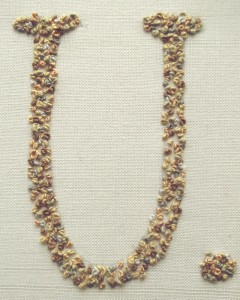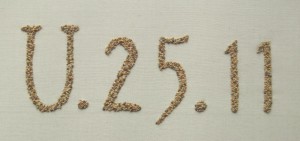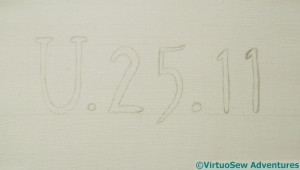Tag: Typed On Camelback
Stitching “Typed on Camelback in a Sandstorm”
The whole idea of this patch is to recall an incident that Mary Chubb describes, in which sand adhered to a freshly-typed page, creating “a rather pretty embossed effect”. In the end, I chose the grid reference of the Expedition House, where the team lived during the digging season.
I used a selection of silk threads from Mulberry Silks, from a colour family called “Old Cotswold”, which I’ve also used for the panel showing the Crock of Gold Hoard. It included a russet, a mid-grey and a very pale greyish-white as well as several sandy colours.
I used all of the colours this time, and discovered that the threads are not all the same, some being finer than others. That’s perfect in this case – some of the grains of sand would be finer than others, and I could accentuate or reduce the differences by using more or fewer wraps in my French Knots. I think it looks really very sandy indeed!
It took a remarkably short period of time. And what’s more, considering that I’m not really a fan of French Knots (I never could get the hang of them when I began embroidering), I rather enjoyed it. Although I must admit, it was beginning to get quite tricky, what with all those layers of thread. I swapped over to a sharp needle and even that was a struggle!
Still, that’s another piece completed…
And, as a bonus – an animation. This was put together by Simon Walters (@cymplecy on Twitter), using some photos I provided. I’m impressed with what he produced, considering that I didn’t take the pictures in a very controlled environment, and it will give you some idea of the view I had as I built up the effect, colour by colour
Thank you, Simon!
Typed on camelback in a sandstorm
One of the reasons Mary Chubb was sent out to Egypt with the Expedition was to ease the administrative burden in London by bringing the administration of the dig under control. In the nineteen twenties, of course, typing was not the mundane skill it has become, and although there was a typewriter in the Dig House, the excavation directors were not skilled in its operation, producing typed reports that looked, in Mary’s words, “as though they had been typed on camelback in a sandstorm”. The first task when a report arrived had always been to retype it into a more legible format so that no-one other than the secretaries would have to struggle to decipher it.
When she is out in Egypt, she soon discovers that some of the difficulties are not easily surmountable, even by an experienced typist. Sand adheres to the damp ink left by the typewriter ribbon, creating “a rather pretty embossed effect”, which sadly she isn’t always in the mood to appreciate, especially when dragged away from difficult, painstaking typing of lists to help with the excavation of delicate finds..
It was easy enough to work out how to represent the sand sticking to the paper – close-packed French knots in a mixture of sandy colours – but not so easy to decide what text to use. Maybe “faience”, a commonly used material for jewellery and ornaments? The names of the expedition members? References ascribed to finds?
In the end I settled on “U.25.11”, which was the site grid reference for the Expedition House, which was built up on the remains of an original house of the Amarna period. I don’t, of course, know precisely which typewriter Mary used, so I have sketched onto the fabric something that looks a little bit like typescript. It isn’t exactly right, but the letter and digit forms have been sketched from looking at the letters in a typescript we recently found, of an article my father wrote in the 1960s. My whole family is going to be involved in this project, whether they like it or not, and by whatever circuitous route I may devise…




